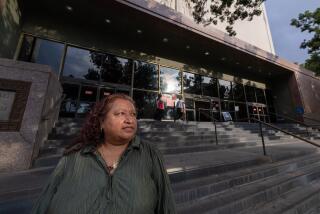Rounding Up New Ideas for Trial Courts
On Thursday mornings, William A. MacLaughlin will trade in faded blue jeans and cowboy boots for a crisp suit and drive downtown to take the reins of the world’s largest trial court.
MacLaughlin, the new presiding judge of the Los Angeles County Superior Court, has cut back his ranching time during the week since taking on new administrative responsibilities.
Most days, he spends the extra hour on the freeway, commuting downtown. But Mac- Laughlin has set aside Thursday mornings for riding and roping at his ranch near Agoura Hills, with 15 horses, chickens, cats, dogs and two burros.
As the new presiding judge, MacLaughlin has big plans, envisioning the court as a statewide leader in educating judges and setting judicial branch policies.
MacLaughlin, whose term officially begins Saturday, plans improved training for his court’s 583 bench officers -- whether it is teaching family law judges the basics of mediation or giving jurists sitting in misdemeanor courts a lesson on how to sentence felony offenders.
“Mandatory education is coming statewide,” he said in an interview. “I would like us to have a voice in the content and form” of those proposed rules.
With that in mind, Mac- Laughlin hopes to stay one step ahead of state judicial leaders as they ponder whether to require judges to take specialized classes to update their skills. Previous attempts have failed, in part because judges are elected state officers whose job requirements are set by the state Constitution, not any licensing board.
MacLaughlin’s ambitious two-year agenda also includes efforts to end years of self-imposed isolation by the Los Angeles court leadership. He says strengthening strained relationships will give his court a voice in statewide policymaking.
“The Los Angeles court needs to take a greater role in leadership in the state judiciary,” the judge said, acknowledging that its failure to participate more actively in statewide decision-making has limited its influence.
A freer flow of ideas could help local courts as well as the entire third branch of state government. “We expect to learn” from others, MacLaughlin said, “but ... they can learn from us too.”
Until now, the Los Angeles court has been locked in a power struggle with state court leaders over everything from budgets to whether lawyers must attach a blue backing to all court filings. As a result, Los Angeles judges -- who make up a third of California’s jurists -- have little sway within the judicial branch.
The break began a decade ago when state legislators consolidated the power of the judicial branch, taking funding and other powers away from individual counties and placing them with the state. No longer could Los Angeles judges simply cross the downtown plaza to lobby county supervisors for money -- either to keep courtrooms open or to enhance their own state benefits.
One way MacLaughlin hopes to improve his court’s statewide standing is to increase its participation in such crucial issues as writing the rules that govern trial courts. He said he plans to create local committees to work closely with state groups studying the same issues.
In addition, he has asked Chief Justice Ronald M. George to appoint another member of the Los Angeles bench to the Judicial Council of California, the policymaking arm of the branch. “Los Angeles should have a third seat,” he said.
Judges J. Stephen Czuleger, who succeeds MacLaughlin as assistant presiding judge, and Michael Nash, who presides over the Juvenile Court, are already members.
“I’m not expecting that we’re always going to get our wish. I’m not expecting that we are going to dictate what the policies are,” MacLaughlin said. “But I do think that an earlier recognition and knowledge of what issues are being addressed and greater opportunity for input” will help the state judiciary as a whole.
While the judicial council adopts statewide policies in an attempt to bring greater consistency throughout the state, the new presiding judge warned that if state leaders try to micromanage local courts “they will lose the ingenuity and creativity” those courts can offer.
MacLaughlin has other plans. He wants family law judges to set aside a day or two each week to hear disputes involving those who cannot afford lawyers. The way he sees it, the courts will have added resources available on those days to help people complete court forms correctly and offer other general assistance.
The pilot program will begin in three downtown courtrooms, he said, and eventually be used in family law courts countywide.
MacLaughlin said he wanted to offer family law judges, and eventually civil trial jurists, training to improve their mediation skills. He also hopes to increase the number of complex litigation courts from six to seven.
The chief judge also said he has talked to state legislators about securing additional funds for the justice system, including $100,000 that could be used to open six more domestic violence clinics and three to four additional self-help centers in Los Angeles County.
Named to the bench by former Gov. Pete Wilson in 1992, MacLaughlin was elected by his peers to become presiding judge earlier this year. He succeeds Robert A. Dukes, who returns to a trial court in Pomona after two years at the helm.
MacLaughlin, 69, graduated from Yale Law School, served in the Army and practiced civil law for three decades before becoming a judge. He served as assistant presiding judge for two years.
More to Read
Get the L.A. Times Politics newsletter
Deeply reported insights into legislation, politics and policy from Sacramento, Washington and beyond. In your inbox three times per week.
You may occasionally receive promotional content from the Los Angeles Times.










